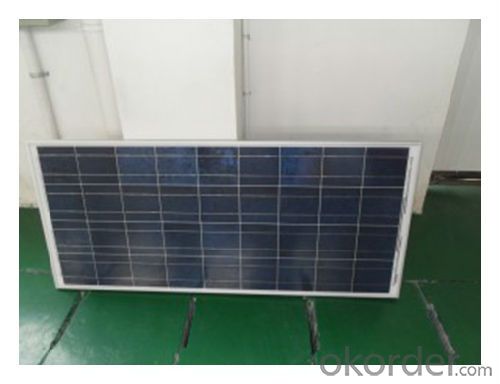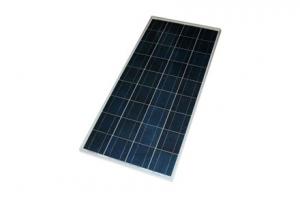Solar Modules Poly-crystalline 140W 156*156 Module
- Loading Port:
- China Main Port
- Payment Terms:
- TT or LC
- Min Order Qty:
- -
- Supply Capability:
- -
OKorder Service Pledge
OKorder Financial Service
You Might Also Like
PV systems use the most abundant energy source on the planet, solar radiation, to generate electricity. They are silent, consume no fuel and generate no pollution. They also contribute to the reduction of greenhouse gas emissions; a 2kW PV system on a house will prevent the emission of about 40 tonnes of CO2 during its projected 30 year lifetime. Furthermore, the use of PV will reduce your electricity bills and exposure to fluctuating and steadily rising electricity prices.
Customers benefit from our progressive system innovations. Around the world, we meet our customers' desire for the greatest possible reliability, long-term performance and aesthetic integration. No matter which kind of roof – we always have the right solution.

Max-power (W) | 140 |
Max-Power Voltage (V) | 18.3 |
Max-Power Current (A) | 7.65 |
Open-Circuit Voltage (V) | 21.95 |
Short-Circuit Current (A) | 8.25 |
Mechanical Characteristics
Cable type, Diameter and Length | 4mm2, TUV certified, 1000mm |
Type of Connector | Compatible with MC4 plug |
Arrangement of cells | 4*9 |
Cell Size | 156*156 |
Dimension | 1482*676*40 |
Weight | 12Kg |
Glass, Type and Thickness | High Transmission, Low Iron, Tempered Glass 3.2mm |
Features
Guaranteed positive tolerance 0/+5w ensures power output reliability
Strong aluminum frames module can bear snow loads up to 5400Pa and wind loads up to 2400Pa.
Excellent performance under low light environments (mornings evenings and cloudy days)
12 years for product defects in materials and workmanship and 25 years for 80% of warranted minimum power.
Certifications and standards: IEC 61215.
Manufactured according to International Quality and Environment Management System (ISO9001, ISO14100).

FAQ
Q: Do you have any MOQ limit?
Our MOQ is 200 pieces.
Q: How long is the warranty period for the solar modules?
15 years 90% of its nominal power rating.
25 years 80% of its nominal power rating
Q: What kind of loads can I run on PV?
With a correctly designed PV system you can power almost any electrical load. However, as the load size increases the expense also increases. Loads like hot water heaters, air conditioners, room heaters and electric stoves should be avoided. The added cost of trying to power loads like these is very cost prohibitive. If these loads have to be powered it will be a lot less expensive to change the appliance to use an alternative fuel type like propane.
Q: When do I need a charge controller and why?
The safest way to figure out if you need a charge controller is to take Battery Amp Hour Capacity and divide this by the Solar Panel max. power amp rating. If the quotient is above 200, you don't need a controller. If the number is less than 200 than you need a controller.
- Q:Can a solar controller be used with solar panel balcony mounts?
- Yes, a solar controller can be used with solar panel balcony mounts. A solar controller is responsible for regulating the amount of power that is supplied to the battery from the solar panels. It helps to prevent overcharging and ensures efficient energy management. Regardless of the mounting location, such as a balcony, a solar controller can still be used to optimize the performance and protection of the solar panel system.
- Q:Can a solar controller be used with solar-powered indoor educational systems?
- Yes, a solar controller can be used with solar-powered indoor educational systems. A solar controller is designed to regulate the flow of electricity generated by solar panels, ensuring that the energy is used efficiently and effectively. This is particularly useful in indoor educational systems, where the solar panels may not receive direct sunlight or may be subject to varying light conditions. The solar controller can optimize the energy generated by the solar panels and ensure a stable power supply to the educational system, regardless of the lighting conditions. Additionally, a solar controller can also provide important monitoring and control functions, allowing users to track the energy production, manage battery charging, and even integrate with other systems or devices. Overall, using a solar controller with solar-powered indoor educational systems can enhance their performance, reliability, and sustainability.
- Q:What is the input voltage range of a solar controller?
- The input voltage range of a solar controller typically depends on the specific model and its design. However, most solar controllers are designed to operate within a wide range of input voltages, typically between 12V and 48V.
- Q:What is the purpose of the load output on a solar controller?
- The load output on a solar controller serves the purpose of supplying power to a connected load, such as lights or small appliances, directly from the battery of the solar panel system. This feature allows for the utilization of solar energy when the sun is not shining or when the solar panel system cannot generate sufficient power to meet the load requirements. By directly connecting the load to the battery, the solar controller ensures a consistent and stable power supply to the load, thus maximizing the efficiency and reliability of the solar system. Moreover, the load output often incorporates various protection features, including overcurrent and overvoltage protection, to safeguard the connected load from potential damage. In summary, the load output on a solar controller enhances the functionality and versatility of a solar panel system by enabling the utilization of solar energy even in less favorable conditions for power generation.
- Q:Solar water heater all intelligent controller how to install
- The controller can also control the electric heating. When the electric heating key is pressed, the controller turns on the power of the electric heater 7 and the electric heater operates until the user specifies the temperature. When the temperature drops below the specified temperature 3-5 degrees, the controller restarts the electric heating and heats the water to the specified temperature. Users can also specify the heating time, at a time, the temperature of the solar water tank can not reach the set temperature, the controller will turn on the electric heater, the water tank to the water set to the temperature so far. The controller also has a protective effect, and when the water level drops to a certain point, the electric heating stops until the water level rises above that point. (Usually 50% of the water level).
- Q:Can a solar controller be used with multiple batteries in parallel?
- Yes, a solar controller can be used with multiple batteries in parallel. Parallel connection of batteries allows for increased capacity and longer battery life, while the solar controller ensures proper charging and prevents overcharging of the batteries.
- Q:Can a solar controller be used with a solar-powered pool heating system?
- Yes, a solar controller can be used with a solar-powered pool heating system. A solar controller helps regulate the flow of water through the system, ensuring efficient heat transfer from the solar panels to the pool. It can also monitor and adjust temperature settings, provide system diagnostics, and automate operations, enhancing the overall performance and functionality of the solar-powered pool heating system.
- Q:Can a solar controller be used with solar-powered gates?
- Yes, a solar controller can be used with solar-powered gates. The solar controller helps regulate and optimize the charging of the gate's solar panels, ensuring efficient power utilization and preventing overcharging or damage to the batteries. It also allows for monitoring and controlling various functions of the gate system, such as opening and closing times, security features, and power management.
- Q:What is the maximum current rating for a solar controller?
- The maximum current rating for a solar controller typically depends on the specific model and manufacturer. However, common solar controllers have maximum current ratings ranging from 10 to 100 amps.
- Q:Can a solar controller be used with solar panels of different technologies (e.g., monocrystalline, polycrystalline)?
- Yes, a solar controller can be used with solar panels of different technologies. Solar controllers are designed to regulate the charging process and manage the power flow between the solar panels and the batteries. They are compatible with various solar panel technologies, such as monocrystalline and polycrystalline, as long as the voltage and current specifications of the panels are within the supported range of the solar controller.
1. Manufacturer Overview |
|
|---|---|
| Location | |
| Year Established | |
| Annual Output Value | |
| Main Markets | |
| Company Certifications | |
2. Manufacturer Certificates |
|
|---|---|
| a) Certification Name | |
| Range | |
| Reference | |
| Validity Period | |
3. Manufacturer Capability |
|
|---|---|
| a)Trade Capacity | |
| Nearest Port | |
| Export Percentage | |
| No.of Employees in Trade Department | |
| Language Spoken: | |
| b)Factory Information | |
| Factory Size: | |
| No. of Production Lines | |
| Contract Manufacturing | |
| Product Price Range | |
Send your message to us
Solar Modules Poly-crystalline 140W 156*156 Module
- Loading Port:
- China Main Port
- Payment Terms:
- TT or LC
- Min Order Qty:
- -
- Supply Capability:
- -
OKorder Service Pledge
OKorder Financial Service
Similar products
New products
Hot products
Related keywords





























